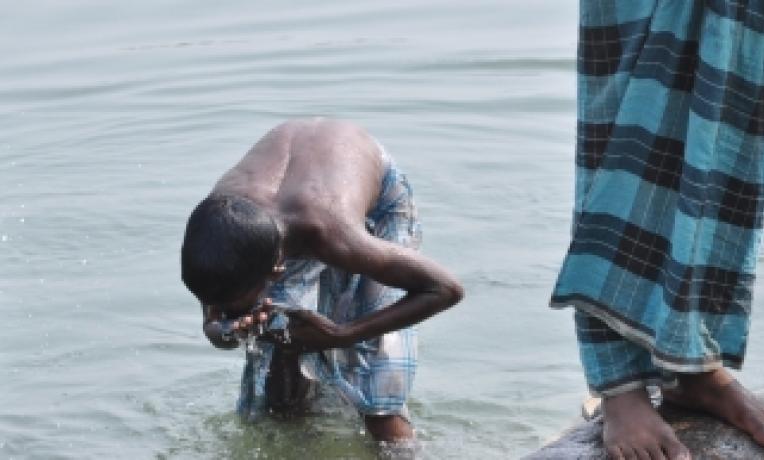Modelling waterborne epidemics
The 22nd of March is UN World Water Day. Each year World Water Day highlights the importance of fresh water for global health: water's critical role in food security; its cultural role in shaping societies worldwide; the impact of natural disasters; the significance of clean water supplies in preventing the spread of diseases.
Caption: A young boy drinking the water of the Meghna River near Matlab (Bangladesh), a place where cholera is endemic
©Photos by courtesy of Professor Andrea Rinaldo

A UN report, unveiled last week at the World Water Forum in Marseille (France), revealed that nearly 800 million people do not have access to a safe water supply, whilst nearly 2.5 billion people lack basic sanitation. This represents a grave threat to global health.
Professor Andrea Rinaldo, an ERC Advanced grantee 2008, is at the forefront of the fast-developing field of ecohydrology with his project 'River Networks as Ecological Corridors' (RINEC). The overarching theme of RINEC is the analysis of how far hydrological changes can be used as an indicator of wider environmental shifts. His study of biodiversity has taken both him and his team across the world, from South Africa to Bangladesh and the Mississippi (US).
"At the start of the project, we had a clear idea about the directions to pursue. We began by studying rivers as ecological corridors for species - how river networks and the management of water resources affect biodiversity for example. We also examined the impact of rivers on populations more widely, addressing questions such as how landscape variations have affected historic population migrations. But our research rapidly developed and entered unexpected fields. We began to explore how far our mathematical models were capable of describing epidemics of waterborne diseases, including cholera." Cholera is one of the world's most virulent infectious diseases, and it thrives in areas with little or no access to adequate sanitation. It causes acute diarrhoea and is also highly contagious.
The team discovered that their mathematical models could be used not just to predict the course of future epidemics, but also to map the progress of ongoing outbreaks. Their findings have the potential to be a powerful tool in what Prof Rinaldo called the "real-time management" of epidemics, helping humanitarian organisations with the "deployment of healthcare resources and life-saving supplies, such as vaccines." Prof Rinaldo explained that they were able to establish a "space-time model of an epidemic's development, a model which is robust and flexible enough to accommodate the fact that epidemics are not regular in their development. They travel in waves, and there are differing rates of infection in different areas."
Their work on model-guided field validation allows them to use new technologies, such as remote sensory equipment. This approach has great potential for the future treatment of epidemics. By modelling the conditions that can lead to the outbreak of epidemics, the researchers have been able to map much more accurately how outbreaks of disease unfold.
The outbreak of cholera on the island of Haiti in October 2010, which followed the dramatic earthquake, transformed the project. Whilst Prof Rinaldo had planned to study the relationship between river networks and the spread of disease, he could not have anticipated that his mathematical modelling would be tested on an ongoing emergency.
As there had not been an outbreak of cholera in Haiti for 200 years, Prof Rinaldo did not need to disentangle the other factors which might have contributed to the epidemic. Cholera was not endemic to the island and susceptibility to the disease could not have been affected by any existing immunities within the indigenous population.
Prof Rinaldo concluded by saying that he felt a "moral duty to do something for the poor." He highlighted the assumptions, both scientific and apocryphal, surrounding acquired immunity to cholera. Such immunity is not permanent. Although the project has made great advances, he also stressed that there is more work to be done in the field. This will enable them to ensure that they are equipped to play a significant part in shaping future responses to epidemics. The aim is to be able to predict the spread of epidemics early enough for medical staff to be on the ground, ready to respond to the situation as it develops.


